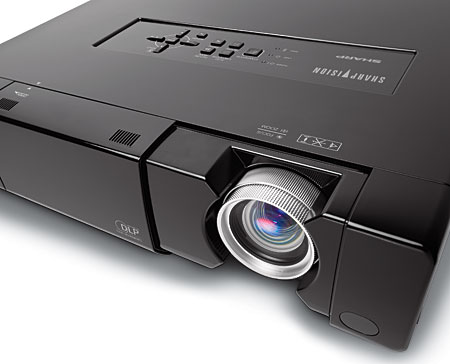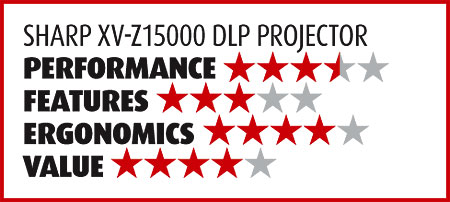Sharp XV-Z15000 DLP Projector Page 2
With Overscan off, the Sharp produced a perfect 1:1 HD pixel map. It also reproduced both below black and above white.
 I’ve always been sensitive to DLP rainbows, the color-separation artifact that often accompanies single-chip DLP reproduction. But the Sharp, with its six-segment, five-speed color wheel, does a good job taming them. I can’t say I never saw them, but they didn’t appear often enough to bother me.
I’ve always been sensitive to DLP rainbows, the color-separation artifact that often accompanies single-chip DLP reproduction. But the Sharp, with its six-segment, five-speed color wheel, does a good job taming them. I can’t say I never saw them, but they didn’t appear often enough to bother me.
Putting It Together
I chose the Movie2 Picture mode for most of my viewing and measurements, which was modified by the usual control tweaks and a full calibration. Movie2 sets IRIS1 to High Contrast, turns on IRIS2 (auto iris), and puts the Sharp in its Low lamp mode (Eco+Quiet).
I was a bit disappointed during my first few hours with the Sharp. Its colors didn’t really bother me, but they were a bit more obvious and less subtly refined than the Epson’s colors. The two CMS options also proved to be ineffective. When I first tried them, I managed to slightly reposition the two most errant colors (green and yellow)—but the controls still weren’t flexible enough to produce an accurate color gamut. When I re-checked the results later in the review, the CMS adjustments I had made no longer had any effect at all. My settings were still there, but the measurements were the same with the CMS on or off. I left them off for the remainder of the review.
However, the Sharp has a skewed color gamut. (In fairness to Sharp, creative rather than accurate color gamuts are almost universal in the consumer display business.) Still, not many users will object to its overall color performance, which is largely thanks to its exceptional post-calibration gray-scale performance.
Given a good source, fleshtones and greens—the two colors that are easy to spot when they look wrong—were nearly always believable. Fleshtones were a bit too warm looking, which was possibly due to the projector’s oversaturated reds. But rich, deep reds—deeper than the HD color standard specifies—turn heads. That’s probably why they’re so common in showrooms. The Sharp’s blue was a little undersaturated, but the eye is very forgiving of blue errors.
The Sharp’s black level and shadow detail ranged from very good to superb—but only with the auto iris (IRIS2) engaged. Without it, the Sharp’s picture on really dark scenes—those gray-on-black monsters with little intra-scene contrast that separate the real-deal projectors from the pikers—looks drab, gray, and washed out. As rare as such scenes are, most movies have a few of them. When they do turn up, their gray-fog look can take you clean out of the movie.
If you turn on the Sharp’s IRIS2 (Auto) setting, it’s a very different story. A good example of this is in chapter 10 of The Da Vinci Code (Blu-ray). It takes place inside a car at night. Without IRIS2, forget it. However, with IRIS2 engaged, this very dark scene has admirable punch and contrast, with a look that’s consistent with the rest of the film.
Given that impressive performance, I wish I could report that the Sharp’s auto iris is seamless in its operation, but it’s not. On difficult material, you can sometimes see it pump for a fraction of a second here and there as it searches for just the right setting. This generally happens rapidly, and if you blink, you’ll miss it. In the first 2 minutes of chapter 2 of The Da Vinci Code, for example, a dark sequence with a lot of contrast changes, the brightness pumped visibly at least four times. Several dark scenes in the Blu-ray release of The Robe also triggered a flurry of brightness flicker.

But this pumping wasn’t common on most program material. Since I found it far less objectionable than the degraded blacks that came when I turned off the auto iris, I kept the iris on and tolerated the occasional artifact.
The Sharp’s auto iris also dramatically alters the projector’s measured gamma. Changes in gamma usually alter the image brightness in the midtones, but they should not change the black and peak white levels. Higher gamma numbers make the overall image appear darker; lower numbers make it lighter. Most experts recommend a playback gamma that’s between 2.2 and 2.4. The Sharp’s gamma (with the Gamma control on –2) was a solid 2.2 with the auto iris off. It dropped to an average of around 1.7 with it engaged.
Surprisingly, this very low gamma did not lighten and wash out the image as you might expect. Not at all. In fact, the changes (auto iris set to on or off) were often subtle, particularly on mid-bright to bright scenes.
The Sharp also produces exceptional image detail. Its single-chip DLP design helps here. The convergence of red, green, and blue images is not hostage to possible misalignment of the three separate imaging chips found in other projection designs. There also doesn’t appear to be significant chromatic aberration in the image. That is, the projector’s optics don’t degrade the convergence of the colors across the screen. While the Sharp’s limited zoom range and lack of lens shift initially put me off, these omissions, which simplify the lens design, might contribute to better optical quality than you expect at this price.
For whatever reason, the Sharp’s resolution on test patterns was also marginally better than the Epson 6500 UB’s. I can’t say that the two significantly differed in this respect with real program material on my relatively small screen. However, there’s still something about the way a DLP conveys sharpness without artifice that gives a different, often crisper image than an LCD or LCOS projector provides. Some videophiles like this; others find it a bit digital looking and prefer the more analog appearance of LCD and LCOS designs. (This is an… um… analogy, of course. All of these imaging technologies are digital. I could have used the word hard here instead of digital, and soft instead of analog. But that would suggest a much more pronounced difference than I’m trying to convey.)
Despite the minor problems I’ve noted—this is, after all, a near-budget projector—the Sharp provided me with many hours of entertainment. When I tell you that I actually enjoyed the last two-thirds of Paul Blart: Mall Cop (a weird hybrid of Die Hard, Rambo, and Home Alone), you’ll guess correctly that I’m as much of a sucker for silly slapstick as I am for animation, sci-fi, and historical drama. But more to the point, thanks to the mall scenes that dominate much of the film (and allow for loads of product placements!), the bright color and detail in this Blu-ray transfer really clicked on the Sharp. I watched the whole movie thinking mainly about the story (OK, maybe saying I was thinking about this story is a stretch). I wasn’t distracted by anything the projector was doing wrong. On those occasions when I yanked myself back into critical mode before the next pie-in-the-face moment (though in truth no pies were harmed and only one was eaten in the making of this motion picture), my impressions were nearly always upbeat.
Conclusions
The Sharp’s post-calibration gray scale is exceptionally accurate, and the video processing is as good as it gets. Its bright images jump off the screen, and the blacks and shadow detail (with the auto iris engaged) aren’t far removed from the best. The image is crisp and clean, and its color, except where compromised by the program material, never looks odd or wrong.
And not the least of the Sharp’s desirable attributes is its cost. A quick Internet search revealed that the XV-Z15000’s average sales price is considerably less than $2,500. In reality, this makes it far cheaper than the Epson (even at its discounted prices), despite their similar MSRPs. The only troubling fly in the ointment is the Sharp’s unusually high ($600) lamp replacement cost.
The Sharp certainly deserves a recommendation, but it must be a cautious one. The shortcomings I’ve described—like its sometimes obvious auto iris operation, inaccurate (and non-correctable) color gamut, and the fact that it doesn’t display 1080p/24 sources in their native frame rate or a direct multiple of that—won’t please all possible buyers. But the price is right, and my time with it was never less than a fun ride.

- Log in or register to post comments























































